The 13 Best Dog Food for Huskies to Buy in 2025
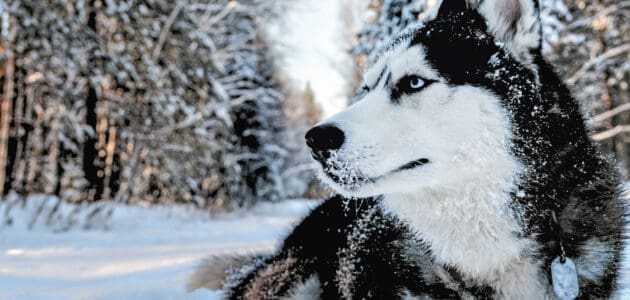
Siberian huskies trace their lineage to Asia and the semi-nomadic Chukchi people. Huskies first gained prominence in the early 20th century when the breed began winning dogsled races.
They’re notoriously talkative and high-energy dogs who can be picky about what food they eat while being susceptible to some common health concerns. So ensuring they’re eating nutritious food that gives them all the fuel they need is vital to their long-term health.
- Most Important Factors in Choosing a Dog Food for Huskies
- Top 13 Best Dog Food for Huskies 2025
- 1. Best Overall Husky Dog Food: Blue Buffalo Life Protection Formula
- 2. Best Premium Husky Dog Food: Orijen Six Fish
- 3. Best Budget Husky Dog Food: IAMS Minichunks
- 4. Best High-Protein Husky Dog Food: Taste of the Wild High Prairie
- 5. Best Food for Active Huskies: Diamond Naturals Extreme Athlete
- 6. Best Food for Sensitive Stomachs: Hill’s Science Diet Sensitive Stomach & Skin
- 7. Best Food for Senior Huskies: Canidae Pure Senior
- 8. Best Food for Husky Puppies: Orijen Puppy
- 9. Best Husky Skin & Coat Health Supplement: ZestyPaws Pure Wild Alaskan Salmon Oil
- 10. Best Husky Vision Health Supplement: ZestyPaws Vision Bites
- 11. Most Affordable Husky Dog Food Topper: The Honest Kitchen Superfood Pour Overs
- 12. Best Dry Husky Dog Food Topper: Stella & Chewy’s Meal Mixers
- 13. Best Wet Husky Dog Food Topper: Purina Beyond Bone Broth
- Complete Guide to Dog Food for Huskies
- Other Food Products for Huskies
- Husky Dog Food FAQs
- Final Thoughts
Most Important Factors in Choosing a Dog Food for Huskies
As with any dietary recommendations for dogs, the individual animal is the single most important factor. There are many peculiarities that could be present in your husky that influence your decision, and you can learn more about how they play a role in food choices here.
Making food choices for your husky involves weighing a variety of factors.
Type of Food
As mentioned, huskies can be picky about food, and it’s common for them to lose interest in food over time. Because of that, many husky owners find they need to employ more than one type of food, including regular dry kibble, supplements, and food toppers or treats.
Grain-Free or Grain-Inclusive
In consultation with your vet, you may decide that you want your husky to eat only grain-free foods, though many vets recommend grain-inclusive options. While proponents of either type of diet can border on aggressive, the truth is that either option can lead to a happy, healthy dog.
Ingredients
Beyond a grain-free or grain-inclusive diet, all dog foods, supplements, and toppers/treats include a variety of other ingredients that can play a role in your dog’s health. Huskies are prone to a few health issues, including eye and vision disorders, skin and coat problems, and poor joint health. Some supplementation can be helpful if your dog has particular health concerns.
Life Stage
Some foods are recommended only for certain phases of a dog’s life (like this one for puppies), though the vast majority of the foods on our list are for adult dogs.
Price
You feed your dog every day, probably multiple times per day. These costs add up, especially for medium-to-large breeds like the husky, so cost is an important factor for the average husky-owning household.
We’ve grouped the products on this list into categories based on their price per pound relative to all others in their category. That means dog foods are grouped together, while supplements were compared to other supplements, and toppers/treats to other toppers and treats. Here’s a look at how the prices break down by category:
Dog Food
- $: $1-$1.50
- $$: $1.51-$2.99
- $$$: $4+
Health Supplements
- $: <$20
- $$: $20+
Food Toppers
- $: $1-$5
- $$: $5-$10
- $$$: $10+
Top 13 Best Dog Food for Huskies 2025
1. Best Overall Husky Dog Food: Blue Buffalo Life Protection Formula
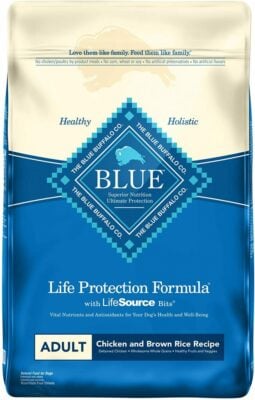
Editor’s Rating:
Why we like it: Blue Buffalo’s Life Protection Formula provides the best balance of high protein content, well-rounded nutrition, and affordability. While it’s not grain-free, all ingredients are healthy, wholesome, and designed with long-term health in mind.
At a Glance:
- Food type: Dry
- Life stage: Adult
- Main protein(s): Chicken, fish, lamb
- Grain: Grain-inclusive
- Major ingredients: Brown rice, barley, oatmeal, pea starch
- Price: $
Why You’ll Like It
While it’s not a viable option for owners who have decided to feed a grain-free diet, protein is the leading ingredient, and all grains are whole grains.
Why Your Dog Will Like It
Huskies aren’t the types to overeat, in fact, quite the opposite. They’re known for being fussy eaters who can become bored with the same food day after day. Luckily, Blue Buffalo’s Life Protection Formula comes in a variety of options, including chicken, fish, or lamb. Plus, the kibble includes Blue’s proprietary Life Source bits, which can provide some added stimulation to help keep huskies interested in what’s in their bowls.
Good to Know
The calorie content is on the high side when compared to similar grain-inclusive foods (like this more affordable option), so owners should watch for overeating, and it may be wise to reduce the amount of daily food during low-activity winter months.
Pros
- Protein-rich
- Affordable
- Flavor varieties
- Whole grains
Cons
- High-calorie count
- Grain-inclusive
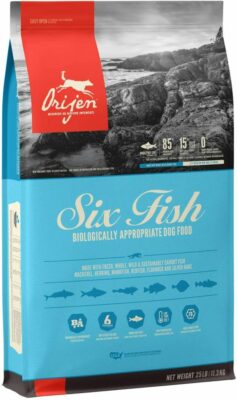
Editor’s Rating:
Why we like it: This is about as close as a commercial dry dog food can get to fresh, raw ingredients. Orijen’s Six Fish formula includes half a dozen types of wild-caught fish.
At a Glance:
- Food type: Dry
- Life stage: Adults and puppies
- Main protein(s): Fish
- Grain: Grain-free
- Major ingredients: Whole Atlantic mackerel, whole Atlantic herring, monkfish, Acadian redfish, flounder, silver hake
- Price: $$$
Why You’ll Like It
Orijen’s Six Fish formulation derives 85% of ingredients from animals, and it’s grain-free, which is important for those leading that no-grain lifestyle. Those benefits come at a premium, as this is by far the most expensive adult dog food on the list.
Why Your Dog Will Like It
Two-thirds of the individual ingredients are either fresh or raw, and protein and flavor from the six types of fish appeal to huskies’ strong predatory instincts. The uniform-shaped kibble may necessitate a topper or other incentive for fickle huskies. Consider a dry topper like this one that won’t smother the fish flavor.
Good to Know
Most of the calorie content is from the fresh, wild-caught fish, but 15% comes from vegetables and fruit, including peas, lentils, beans, carrots, pumpkin, and apples.
Pros
- Protein-rich
- Grain-free
- Wild-caught fish
- Whole fruits and vegetables
Cons
- Expensive
- Uniform kibble size
3. Best Budget Husky Dog Food: IAMS Minichunks
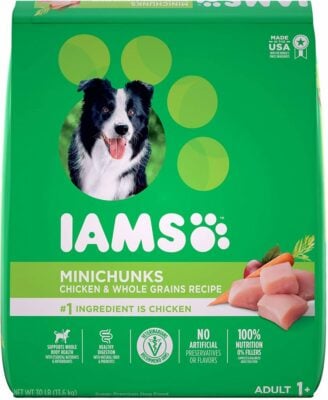
Editor’s Rating:
Why we like it: Iams Proactive Health is a step up from mass-market dog foods of the past, and while it does include grain, the leading ingredient is farm-raised chicken. For owners who can’t afford or don’t prefer to feed grain-free, Iams is hands-down the most affordable option.
At a Glance:
- Food type: Dry
- Life stage: Adults
- Main protein(s): Chicken
- Grain: Grain-inclusive
- Major ingredients: Corn, sorghum, beet pulp, flaxseed, egg
- Price: $
Why You’ll Like It
While it’s the most affordable dry food, it’s a far cry from the low-quality, basic mass-appeal dog food from decades past. The biggest ingredient is farm-raised chicken, and whole grains are the second and third ingredients, meaning it’s both expensive and healthy.
Why Your Dog Will Like It
Whole chicken and chicken fat-based omega-6 acids give food a strong flavor of meat, though it comes in only one flavor option, unlike some others that have lots of varieties, like this Taste of the Wild grain-free food that seems to include every imaginable protein.
Good to Know
The kibble is on the smaller side, which could lead to overeating, though this isn’t usually a problem for huskies. But for owners who’ve noticed their huskies going back for seconds, it’s something to watch. On the other hand, the small kibble can double as a treat or a reward for good behavior.
Pros
- Farm-raised protein
- Whole grains
- Affordable
- Strong flavor
Cons
- Grain-inclusive
- Uniform kibble
4. Best High-Protein Husky Dog Food: Taste of the Wild High Prairie
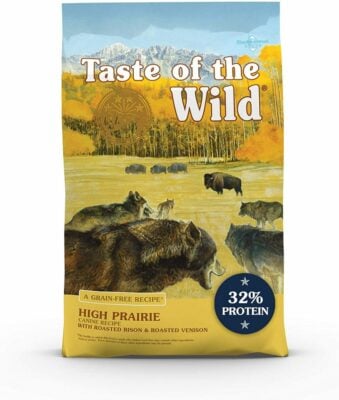
Editor’s Rating:
Why we like it: Taste of the Wild’s High Prairie formulation is a high-protein, grain-free option that adds quality fruits and vegetables at a lower price than some other high-protein foods out there.
At a Glance:
- Food type: Dry
- Life stage: Adults
- Main protein(s): Bison, venison
- Grain: Grain-free
- Major ingredients: Sweet potatoes, peas, potatoes
- Price: $$
Why You’ll Like It
About a third of the content of this food comes from protein, which for the High Prairie version is bison and venison, and those are accompanied by fruits and vegetables like sweet potatoes, peas, and berries. In addition to providing additional low-calorie content, these ingredients bring in antioxidant properties, which can help improve skin and coat health.
Why Your Dog Will Like It
The flavors of exotic meats mirror the types of prey your dog’s husky ancestors might have eaten, and other flavors in the product line include Pacific Stream (salmon), Sierra Mountain (lamb), and Ancient Wetlands (duck).
Good to Know
It’s in the middle of the price range despite being made from sustainable sources, which contrasts with the luxury of Orijen’s Six Fish formulation. The kibble is drier than most others, which could be an issue for huskies who are especially fussy about their food. Try a wet food topper like Purina Beyond Bone Broth to keep things moist, or just add a bit of water.
Pros
- Protein-rich
- Grain-free
- Exotic flavors
- Antioxidant ingredients
Cons
- Somewhat pricey
- Extra-dry kibble
5. Best Food for Active Huskies: Diamond Naturals Extreme Athlete

Editor’s Rating:
Why we like it: Diamond Naturals’ Extreme Athlete formulation provides protein and calories that can help keep high-energy dogs going — and going and going.
At a Glance:
- Food type: Dry
- Life stage: Adult
- Main protein(s): Chicken
- Grain: Grain-inclusive
- Major ingredients: Rice, chicken fat, barley, egg
- Price: $
Why You’ll Like It
It’s inexpensive and high in protein that comes from cage-free chicken. The high-calorie count is excellent for large huskies, especially active dogs, and glucosamine and chondroitin can help avoid joint pain, another regular issue for medium and large huskies. It may also help ease symptoms of hip dysplasia, which is common in huskies.
Why Your Dog Will Like It
The chicken flavor will appeal to their predatory instincts, and the high-calorie count will keep them full and feisty.
Good to Know
Dogs with refined palates will probably find the flavor to be on the bland side, and the kibble is a uniform size with no hidden surprises. So, it may be wise to add a flavor enhancer or incentivizing topper.
Pros
- Cage-free chicken
- Inexpensive
- Calories from protein
- Joint-health ingredients
Cons
- Bland flavor
- Uniform kibble
6. Best Food for Sensitive Stomachs: Hill’s Science Diet Sensitive Stomach & Skin

Editor’s Rating:
Why we like it: Huskies as a breed can be prone to stomach problems that can be triggered by foods that are too rich, so Hill’s Science Diet is ideal for owners whose furry friends may have digestive issues.
At a Glance:
- Food type: Dry
- Life stage: Adult
- Main protein(s): Chicken
- Grain: Grain-inclusive
- Major ingredients: Rice, peas, barley, sorghum, egg
- Price: $$
Why You’ll Like It
This version of Hill’s Science Diet is formulated for dogs with problems digesting other foods, as it includes ingredients designed for optimal digestion. Research has suggested huskies may have a higher rate of issues like inflammatory bowel disease, and Hill’s Science Diet for sensitive stomachs and skin may give you easier, ahem, pickup times.
Why Your Dog Will Like It
The small kibble with chicken flavor, along with vitamin E and fatty acids for coat health, will have your husky looking and feeling sharp.
Good to Know
A grain-free option is available, and that version comes with medium-sized kibble. However, it’s in the middle of the price range, so it may be wise to opt for a smaller bag at first before committing to a big one. This is especially important if your dog has had previous problems adjusting to new food. Also, the flavor is bland, though that’s by design. Still, the gourmand huskies in your life might not be enticed by the taste of this food.
Pros
- Protein-rich
- Formulated for digestive health
- May improve coat
- Grain-free option available
Cons
- Grain-inclusive
- Bland flavor
7. Best Food for Senior Huskies: Canidae Pure Senior
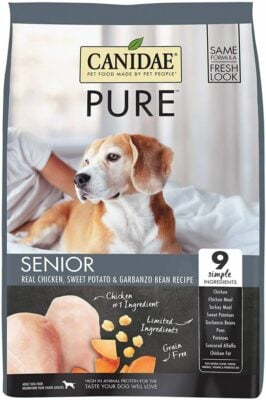
Editor’s Rating:
Why we like it: Canidae’s Pure Senior formulation provides a limited set of ingredients that adds probiotics, antioxidants, and other nutrients to help boost health in your husky’s golden years.
At a Glance:
- Food type: Dry
- Life stage: Senior
- Main protein(s): Chicken
- Grain: Grain-free
- Major ingredients: Sweet potato, garbanzo beans, peas, potatoes
- Price: $$
Why You’ll Like It
Limited ingredients help keep senior dogs’ sensitive systems from being upset by overly complicated or rich foods, while probiotics and antioxidants added after the cooking process support immune, digestive, and skin health. It also includes zinc sulfate, which can help stave off a skin condition common in older Siberian huskies, which can result in patches of bare skin and other dermatological symptoms. Learn more about husky health problems here.
Why Your Dog Will Like It
It’s bland, so it’s less than ideal for huskies who demand stronger flavors, but the chicken taste is designed to appeal to your dog’s inner wolf.
Good to Know
The kibble is medium and uniform in size, which could be a challenge for dogs who are easily bored with their food. Multiple flavors are available, though none in the senior line. Other formulations offer proteins like duck, lamb, goat, venison, salmon, and wild boar, but all versions are relatively pricey, so it’s best to try a small bag first to see if it meets with your dog’s approval.
Pros
- Grain-free
- Limited ingredients
- Antioxidants
- Medium kibble
Cons
- Only one flavor for seniors
- Somewhat pricey
8. Best Food for Husky Puppies: Orijen Puppy

Editor’s Rating:
Why we like it: Orijen’s formulation for puppies is high in protein, appealing to young huskies, but it’s also filled with fat and calories to help husky pups grow strong.
At a Glance:
- Food type: Dry
- Life stage: Puppy
- Main protein(s): Chicken, turkey, flounder, mackerel
- Grain: Grain-free
- Major ingredients: Egg, lentils, beans, peas
- Price: $$$
Why You’ll Like It
Like their adult formulation, Orijen’s puppy food is wholesome and loaded with protein. In fact, 85% of the grain-free content comes from animal ingredients, and the puppy formulation adds calories and fat to promote growth.
Why Your Dog Will Like It
Orijen’s puppy food has strong meat flavors from the variety of proteins included. For those keeping track, that’s chicken, turkey, flounder, and mackerel, as well as organ meats from multiple types of poultry.
Good to Know
The kibble is small and uniform in size, so it’s also a good option for training your new arrival. That said, it’s the most expensive food on our list, though since it’s a puppy food, you aren’t signing up for feeding it for the rest of your dog’s life. If you’re not sure about when to switch your husky pup to regular food, check out the most recent thinking here.
Pros
- Grain-free
- High protein
- Flavorful
- Wholesome secondary ingredients
Cons
- Expensive
- Uniform kibble
9. Best Husky Skin & Coat Health Supplement: ZestyPaws Pure Wild Alaskan Salmon Oil
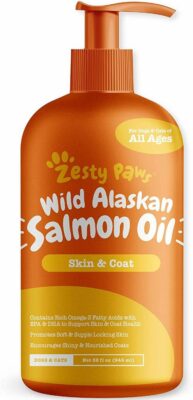
Editor’s Rating:
Why we like it: ZestyPaws has a variety of excellent supplements, but their Pure Wild Alaskan Salmon Oil is the best for boosting skin and coat health because of its low cost and ample size.
At a Glance:
- Food type: Oil supplement
- Life stage: Adults and seniors
- Main protein(s): N/A
- Grain: N/A
- Major ingredients: Salmon oil
- Price: $
Why You’ll Like It
A little goes a long way, and one pump in your dog’s food can provide an added incentive to eat, and improve the health and appearance of their skin and coat. This is helpful in avoiding some of the skin and coat health problems that can often afflict huskies.
Why Your Dog Will Like It
Because the only active ingredient is salmon oil, it provides a strong fish taste that will speak to your husky’s rugged, sled dog roots.
Good to Know
The pump can be messy to operate, though it’s easy to get the hang of it. It’s also probably too much fat to give a puppy or an adult dog with a sensitive digestive system.
Pros
- Inexpensive
- Long-lasting
- Pure salmon oil
- Improves coat and skin
Cons
- High-fat content
- Can be messy
10. Best Husky Vision Health Supplement: ZestyPaws Vision Bites

Editor’s Rating:
Why we like it: The soft chewies are ideal for older dogs, though it’s also potentially wise to give these to younger dogs as well, as huskies are prone to vision problems that develop over time could turn serious.
At a Glance:
- Food type: Dry supplement
- Life stage: Adults and seniors
- Main protein(s): N/A
- Grain: Grain-inclusive
- Major ingredients: Carrot
- Price: $
Why You’ll Like It
The soft chews are ideal for senior dogs’ aging teeth, and ingredients like cod liver oil and carrot help improve vision. This is great not only for senior dogs but also for huskies of any age. That’s because the breed is prone to three major eye diseases — cataracts, corneal dystrophy, and progressive retinal atrophy. (What other health issues are especially common in Siberian huskies?).
Why Your Dog Will Like It
A strong fish flavor and soft consistency will make it feel like a treat.
Good to Know
This supplement also includes ingredients designed to boost the immune system, though you should be careful when you first give this to your dog. It’s high in fat, which can lead to stomach upset.
Pros
- Soft consistency
- Eye health nutrients
- Strong flavor
- Inexpensive
Cons
- Could cause tummy upset
- High fat
11. Most Affordable Husky Dog Food Topper: The Honest Kitchen Superfood Pour Overs
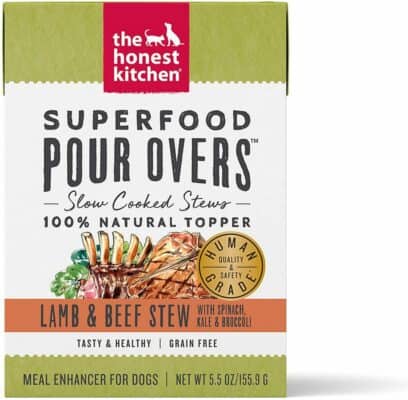
Editor’s Rating:
Why we like it: The Honest Kitchen’s pour-over dog food toppers provide added enticement to get your dog to eat its food, and the superfood versions ramp up the nutritional value, so you’re not just giving empty calories.
At a Glance:
- Food type: Wet food topper
- Life stage: All stages
- Main protein(s): Lamb and beef
- Grain: Grain-free
- Major ingredients: Spinach, kale, broccoli
- Price: $
Why You’ll Like It
It’s easy to open and pour over your dog’s food to add nutrition, as well as boost flavor and make it more enticing. The carton holds two servings and is resealable, so you don’t have to worry about using it all in one serving or messily transferring it to a Tupperware container. Other ingredients include so-called superfoods like spinach, kale, broccoli, and turmeric.
Why Your Dog Will Like It
It tastes good. Maybe not to us, but the strong flavor of lamb and beef (or chicken and turkey in other versions) is irresistible to the average pup. It also comes in a variety pack, which is good for those trying a rotational feeding plan or for finicky eaters. The strong flavor, though, does come with a strong smell, which is worse for owners than their pups.
Good to Know
If you feed twice-daily meals, a case should last about a month, though open containers can be stored in the fridge for up to three days, so you have some flexibility with how much you give and how often.
Pros
- Strong flavor
- Nutritious
- Grain-free
- Inexpensive
Cons
- Used up quickly if given twice a day
- Can be smelly
12. Best Dry Husky Dog Food Topper: Stella & Chewy’s Meal Mixers

Editor’s Rating:
Why we like it: They’re expensive and giving them to your dog can feel a bit indulgent, but your husky will certainly appreciate receiving the compact burst of flavor in these small, freeze-dried meat chunks. She might even think she’s out on the frozen tundra leading a dog sled.
At a Glance:
- Food type: Raw bits
- Life stage: All stages
- Main protein(s): Chicken, beef, duck, lamb, pork, salmon and cod, turkey, seafood
- Grain: Grain-free
- Major ingredients: N/A
- Price: $$$
Why You’ll Like It
Each flavor provides the dog-friendly nutrition of raw protein, which comes from grass-fed, cage-free, or wild-caught animals. You can give a scoop on top of or mixed into dry kibble, or you can dole them out as treats. They are expensive, so you’ll probably want to give less than what’s recommended by the manufacturer.
Why Your Dog Will Like It
Concentrated meat flavor (varieties include chicken, beef, duck, lamb, pork, turkey, fish, and seafood) makes food more exciting and helps provide your husky with the motivation to put up with learning new tricks.
Good to Know
Counting the entire bag, the calorie content is high, though individual bits aren’t overly calorie heavy. Still, giving these out multiple times a day will add up. That said, the non-meat ingredients include vitamins, minerals, and antioxidants, so they’re not empty calories. A word of warning for the squeamish — the bags can contain powdery residue from the freeze-drying process that’s a little off-putting and easily mistaken for mold.
Pros
- Nutritious
- Many flavors
- Grain-free
- Responsibly sourced
Cons
- Expensive
- Freeze-dry residue
13. Best Wet Husky Dog Food Topper: Purina Beyond Bone Broth
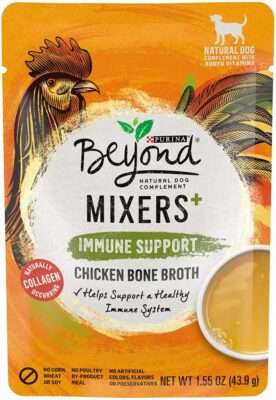
Editor’s Rating:
Why we like it: It’s an easy-to-use flavor enhancer that will make you feel like you’ve crafted your dog’s meal from scratch.
At a Glance:
- Food type: Wet food topper
- Life stage: All stages
- Main protein(s): Chicken
- Grain: Grain-free
- Major ingredients: N/A
- Price: $$
Why You’ll Like It
The easy-to-use flavor enhancer has the additional benefit of providing grain-free nutrition thanks to chicken bone broth enhanced with vitamins to support immune health.
Why Your Dog Will Like It
The strong chicken flavor and gravy-like consistency will make food seem like a special treat, though currently, it’s only made in one flavor.
Good to Know
Purina Beyond Bone Broth doesn’t come in a resealable package, so one pouch is good for only one meal. That means they go fast if you use them with every meal. But while it’s more expensive than The Honest Kitchen broth topper, it’s not as smelly, and you just discard the pouch when you’re done, so it’s even easier to use.
Pros
- Strong flavor
- Easy to use
- Added nutrients
- Grain-free
Cons
- Expensive
- One flavor
Complete Guide to Dog Food for Huskies
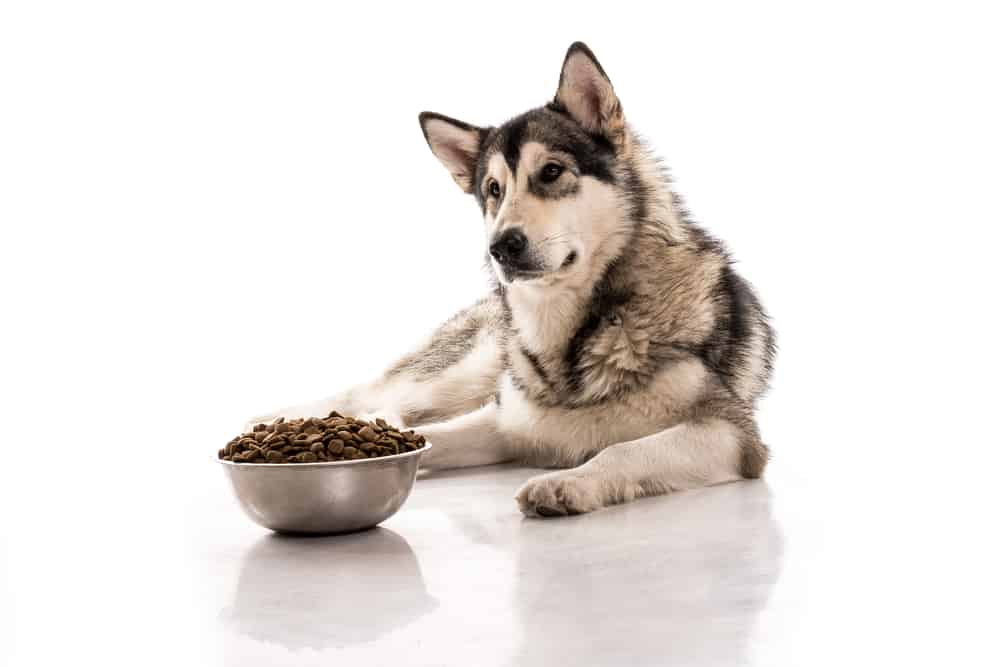
We all want our dogs to lead long, healthy lives, and picking the right food for them is a necessary part of keeping them happy and in good health. Here are the most important things you need to know to reduce guesswork in choosing a food for your Siberian husky.
Every Dog Is Different
Especially if your husky is a pure-bred Siberian husky, there likely are some behavioral and health issues she has in common with others of the breed. That said, every dog is different, and their needs are unique.
So, while our advice below is helpful, it’s important to remember that more than doing what’s best for the average husky, you need to be in tune with what makes your dog unique. That includes things like:
Size
The average adult weight of a female Siberian husky is 35-50 pounds and 45-60 pounds for the average male, but some huskies are much larger, and some are smaller. In consultation with your vet, you should determine how much food your dog needs to eat in a day to maintain a healthy weight.
Age
As dogs age, their nutritional needs change. Puppies need more calories and fat than older dogs to promote healthy growth. That’s why food formulated for puppies, such as Orijen’s puppy food, is packed with building blocks for healthy growth. And some dogs may be less inclined to eat as they get older, which can cause muscle mass to waste away. These are normal parts of aging that you should be able to manage, but if you notice sudden changes in your dog’s behavior, unrelated to their food, and you think it may be related to aging, you should consult with your vet.
Activity Level
Siberian huskies are athletic and tend to be very high-energy, so they’ll need lots of daily activity to maintain physical and emotional health. But some are naturally less inclined to lots of physical activity, and huskies that are less active should generally eat less food to avoid weight gain. Low-calorie foods (like this one) can be helpful in maintaining a healthy weight for less-active huskies.
History
Your dog’s health history is probably the biggest factor outside of age that will determine the best type of food for them. If they’ve never shown issues with digestive problems, then a sensitive-diet food probably isn’t worth it, and if they’ve had grain-inclusive food and thrive on it, there may be no reason to consider a grain-free diet.
Common Husky Health Issues
Huskies’ average lifespan is 12-14 years, which is quite high for a medium-to-large breed. But while they tend to be strong, hearty dogs, there are some health issues that are common to the breed.
Husky owners should monitor their dog for signs of any of these issues, and your vet can provide further guidance if you do happen to notice anything.
Eye Diseases
Siberian huskies are, sadly, prone to three genetic eye diseases, though husky-dominant mixed-breed dogs may be less inclined. According to a study on pure-bred Siberian huskies, 8% had hereditary cataracts, while 3% had corneal dystrophy, and less than 1% had progressive retinal atrophy. In severe cases, blindness and loss of eyes can result.
Huskies should receive annual ophthalmological evaluations starting around 12 months, particularly if there’s a chance they will be involved in breeding (whether intentional or unintentional).
Other vision problems that commonly strike huskies include glaucoma, corneal ulcers, and retinal scarring.
Hip Dysplasia
Like most medium-to-large breeds, Siberian huskies are prone to hip dysplasia, which is an inherited condition that causes hip joints to develop improperly; this leads to arthritis and pain, especially over time or with excess weight gain.
Signs include difficulty walking or rising from a lying-down position, and while hip dysplasia can sometimes be treated with surgery, this is usually reserved for dire cases, so prevention and pain management are usually the best medicines.
Skin Infections
Huskies are commonly afflicted with a skin infection, zinc-responsive dermatosis, which can cause red skin, hairlessness, scaling, and crusty skin around the face and lesions on the foot pads or nose.
This condition can be treated by ensuring that ample zinc appears in the diet.
Tips for Introducing New Food
Most canine health experts recommend not suddenly switching your dog to a new food unless the existing food is unhealthy or harmful. Rather, you should gradually introduce a new food and progressively give the dog more over time.
Schedule
Plan to switch your dog’s food over the course of a week. In the first two days, the dog’s diet should consist of a 2-to-1 ratio of old food to new food. If all goes well, on the third and fourth days, the dog should eat a 1-1 ratio of new and old food. On the fifth and sixth days, the dog should get a 2-1 ratio of new food to old food, and then on the seventh day, they should get only the new food.
If stomach upset occurs at any stage, including vomiting or diarrhea, go back to the previous ratio for two days and then try to proceed again. If, after the second attempt, the dog is still having difficulty digesting the new food, consult your vet.
Senior Food
Siberian huskies are considered seniors around the age of 8, and they should begin receiving food and/or supplements formulated for the unique needs of older huskies. Canidae Pure Senior is a great food option for seniors, and here’s an ZestyPaws Vision Bites are great for supplementation. Again, introduce the food or supplements gradually to avoid digestive trouble.
Maintain Patterns
While you’re gradually introducing your dog to a new food, when and how you feed them shouldn’t change. Keep your normal feeding schedule; if they’re eating twice a day, keep with that. Huskies are notoriously finicky, and upheaval in their mealtimes could make them associate the new food with anxiety, which can perpetuate unhealthy eating behavior.
Be Patient
It’s entirely possible your dog will not like some aspect of the new food, and you may notice as you mix the old and new that your dog is only eating their old food. That’s fine, and you should keep going with the gradual change. Chances are your dog will eventually get over it and eat the new food, but if by the fifth or sixth day of the schedule, they’re still not eating the new food, consider keeping them on their old food until you can find one they like.
Other Food Products for Huskies
Huskies are well known for not only for being beloved by their families, but also for being difficult to care for. Consider some of the following products to help keep your husky friend happy and healthy.
- Dog Whistles: Huskies are one of the most intelligent breeds in the world, known to be smart, caring, and easy-to-train. As intelligent dogs, they take well to whistle training. Check out a list of our favorite dog whistles to help with training.
- Retractable Leashes: Huskies love to have freedom, but sometimes can be excitable. Pick up a retractable leash for a good balance of control and freedom.
- Pooper Scoopers: As one of the biggest dog breeds, huskies both eat and poop a lot. Make your life a bit easier with a high-quality dog pooper scooper.
- Food Toppers: If you’ve got a picky eater or a dog that needs some supplementation, consider adding a food topper to your dog’s dry food. They make a variety of food toppers, some for health, some for older dogs, and some as a simple treat.
Husky Dog Food FAQs
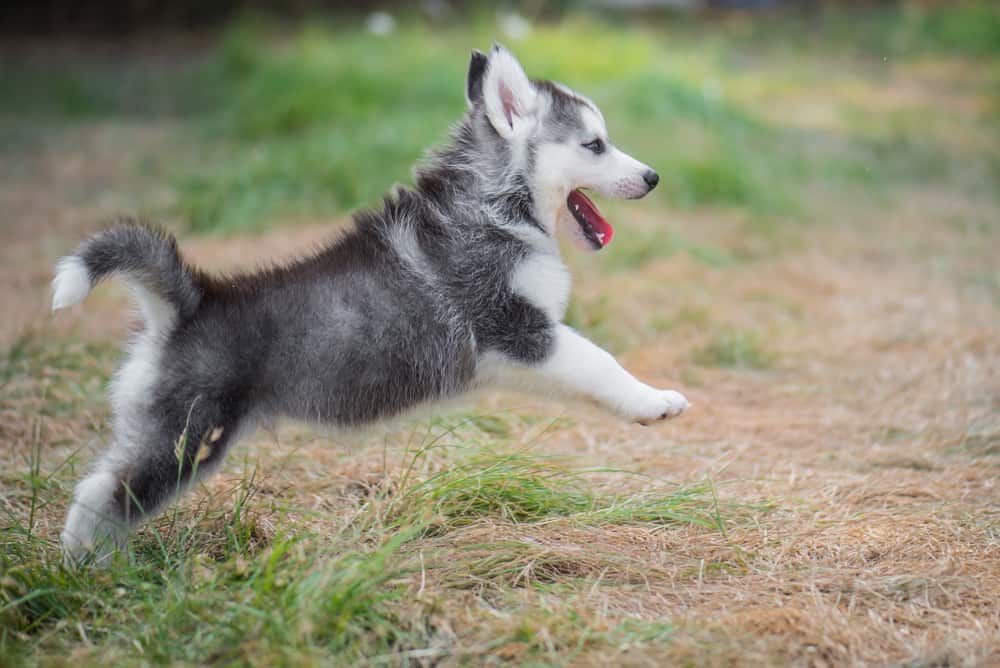
Here’s a look at some of the questions readers most frequently ask about picking a good dog food for Siberian huskies.
How Much Food Should I Feed My Husky?
This depends on the size and weight of your dog, but unlike some other breeds, Siberian huskies are not prone to overeating. In fact, many husky owners find they have a tough time getting their dogs, even puppies, to eat all their food. So, it’s important to make sure your dog is getting enough calories to keep up with their activity level and to maintain good overall health.
Your mileage may vary, but adult huskies should eat about 2 cups of dry food per day, less if the food is especially high-calorie and more if it’s less calorie-dense.
What’s the Safest Way to Transition My Husky to a New Dog Food?
Unless the current food is dangerous, or your dog has a stomach of steel, changing foods should take about a week. Mix their old food with some new food and continue increasing the ratio of new to old over the course of the week until the seventh day, when they should be eating only the new food.
If your dog has a bad reaction, like diarrhea, vomiting, or symptoms of skin or coat problems, go back to the last ratio you used for a couple of days and try again. If on the second attempt, problems persist or get worse, pause the transition and call your vet for further guidance or try a different new food.
When Should I Switch My Husky Puppy to an Adult Food?
Siberian husky puppies are considered adults at around 12-14 months, so at that age, it should be safe to begin transitioning them to adult food. But most adult foods don’t contain adequate nutrition for a puppy’s needs, so it’s always better to err on the side of caution. In other words, a young adult dog will get better nutrition from puppy food than a puppy will get from most foods formulated for adults. Remember, though, that puppy food is high in fat (on purpose), so if your young dog is packing on the pounds, it may be time to start weaning them off.
If you’re unsure how old your husky is, your vet can help you pinpoint her age, but remember that even after they get to around 12-14 months, they may continue growing a bit, though they typically will stop growing by around 15 months.
Adult huskies are about 20-23 inches tall, and by no longer than 18 months, they should reach their full adult size, though it’s not abnormal for Siberian huskies to keep growing a bit until around age 3.
Do Older Huskies Need More Protein?
Once they age out of puppyhood, adult Siberian huskies should eat a diet that’s high in protein, and this is especially true for older huskies. Dogs of all breeds, in fact, typically need to consume more protein than their younger counterparts.
That’s because as a dog ages, it loses muscle mass, which can cause their overall health to decline. Commonly held (but faulty) views from the past suggested that added protein could damage the kidneys, but studies have shown this is not an issue for dogs as it might be for some other animals.
It’s always best to consult with your vet, who can provide advice based on your dog’s unique needs, but generally, senior huskies should consume at least a quarter of their calories from a protein source.
Is the Rotation Diet Good for Siberian Huskies?
While conventional wisdom calls for dogs to eat the same food and only be transitioned to a new food gradually and for specific reasons, there’s another school of thought that calls for what’s become known as the Rotation Diet.
Rotational feeding means switching your pet’s food on a regular basis. There is some evidence to support the theory that the Rotation Diet can reduce food sensitivities and digestive problems. Supporters also say it can help keep a finicky dog from turning their nose up at food.
Owners of huskies may be particularly interested in both of those outcomes, as huskies are not only prone to digestive problems but can become easily bored with their food. Most proponents of rotational feeding recommend sticking within either grain-free or grain-inclusive diets and using different flavors or formulations of food from the same brands, such as the multitude of formulations from Taste of the Wild. This can help ensure that the nutritional content is consistent.
If you’re considering the Rotation Diet, you can read more about it here, but it’s important to remember that even if you’re regularly switching up your dog’s food, whenever you introduce a new food, it must be done gradually to avoid digestive upset.
Final Thoughts
Our dogs are members of our families, and they deserve to eat food that supports their physical and mental health, and Siberian huskies, while overall a very healthy and long-lived breed, are prone to several potentially serious issues that a quality food can help overcome. While most husky owners know it can be a challenge to get them to eat, finding the right food could be a key part of winning the battle of the bowl.




